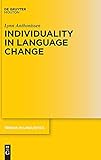Individuality in Language Change / Lynn Anthonissen.
Material type: TextSeries: Trends in Linguistics. Studies and Monographs [TiLSM] ; 360Publisher: Berlin ; Boston : De Gruyter Mouton, [2021]Copyright date: ©2021Description: 1 online resource (XVI, 323 p.)Content type:
TextSeries: Trends in Linguistics. Studies and Monographs [TiLSM] ; 360Publisher: Berlin ; Boston : De Gruyter Mouton, [2021]Copyright date: ©2021Description: 1 online resource (XVI, 323 p.)Content type: - 9783110725711
- 9783110725940
- 9783110725841
- 417.7 23
- P40.5.L54
- online - DeGruyter
- Issued also in print.
| Item type | Current library | Call number | URL | Status | Notes | Barcode | |
|---|---|---|---|---|---|---|---|
 eBook
eBook
|
Biblioteca "Angelicum" Pont. Univ. S.Tommaso d'Aquino Nuvola online | online - DeGruyter (Browse shelf(Opens below)) | Online access | Not for loan (Accesso limitato) | Accesso per gli utenti autorizzati / Access for authorized users | (dgr)9783110725841 |
Frontmatter -- Acknowledgments -- Contents -- Abbreviations -- List of Tables -- List of Figures -- Part I: Introduction -- 1 Introduction -- Part II: Language change and special passives -- 2 A theory of language change -- 3 Systemic change and the rise of the passive -- 4 The development of special passives -- Part III: Connecting individual and community grammars -- 5 The EMMA corpus -- 6 The prepositional passive -- 7 The nominative and infinitive -- 8 Networks in adult cognition -- Part IV: Summary and conclusions -- 9 Conclusion -- 10 Appendix -- Bibliography -- Index
restricted access online access with authorization star
http://purl.org/coar/access_right/c_16ec
Linguists have typically studied language change at the aggregate level of speech communities, yet key mechanisms of change such as analogy and automation operate within the minds of individual language users. Drawing on lifespan data from 50 authors and the intriguing case of the special passives in the history of English, this study addresses three fundamental issues relating to individuality in language change: (i) how variation and change at the individual level interact with change at the community level; (ii) how much innovation and change is possible across the adult lifespan; (iii) and to what extent related linguistic patterns are associated in individual cognition. As one of the first large-scale empirical studies to systematically link individual- and community-based perspectives in language change, this volume breaks new ground in our understanding of language as a complex adaptive system.
Issued also in print.
Mode of access: Internet via World Wide Web.
In English.
Description based on online resource; title from PDF title page (publisher's Web site, viewed 25. Jun 2024)


